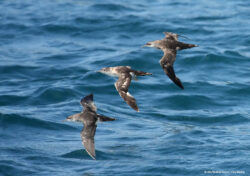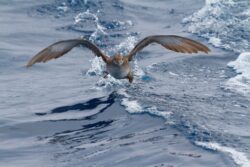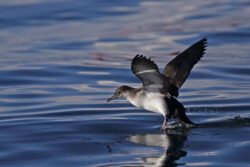After decades of uninterrupted scientific studies about Malta’s seabirds, BirdLife Malta is proud to announce that it will continue studying seabirds on land and at sea following the start of a new project it has embarked on. This will be a Mediterranean-wide collaboration for the conservation of two endemic and threatened Mediterranean seabird species: the Yelkouan Shearwater (Puffinus yelkouan) and the Balearic Shearwater (Puffinus mauretanicus).
Joins forces with another four BirdLife Partners in new LIFE-funded project to preserve and protect two endemic Mediterrean species
Through the new €3.45 million LIFE PanPuffinus! project, BirdLife Malta has joined forces with its BirdLife partners from another four countries (France, Greece, Portugal and Spain) to share knowledge and investigate further the whereabouts of these elusive birds, their interactions with fisheries, and the perils these sea voyagers face during their lifecycles. In view of this BirdLife Malta is happy to have also partnered in this project with Malta’s Department of Fisheries and Aquaculture within the Ministry for Agriculture, Fisheries, Food and Animal Rights. The Ministry has also committed to co-finance this project.
The Balearic Shearwater (Garnija Balearika) is classified as Critically Endangered with Extinction on the International Union for Conservation of Nature (IUCN) Red List of Threatened Species, whilst the Yelkouan Shearwater (Garnija) is classified as Vulnerable. Both species are very susceptible to a changing environment and are affected by multiple marine and terrestrial threats which include pollution, the accidental capture of birds in fishing gear known as bycatch, climate change and severe weather. When it comes to breeding seabirds, invasive alien species and human disturbance are the main threats to these seabirds.
Whilst the Balearic Shearwater is a very rare species for the Maltese Islands, breeding in the Balearic Islands and the south coast of France, the Yelkouan Shearwater can only be found in the Central and Eastern Mediterranean region, with Malta home an estimated breeding population of around 1,600–1,800 pairs.

Both species spend a significant portion of their life on open seas, rarely visiting land except during the breeding season. Due to this they encounter a diversity of threats. Although both species breed exclusively in the Mediterranean, like many other seabirds they wander through different seas, in particular during the non-breeding season. Balearic Shearwaters visit the Atlantic coast of Portugal, France and southern England whilst large numbers of Yelkouan Shearwaters winter in the Black Sea. That is why collaboration across boundaries is vital, and the involvement of a wide array of stakeholders is necessary to ensure safe seas and colonies for these iconic seabirds.
Throughout the delivery of this five-year project (2021–2025), BirdLife Malta will build on the expertise gained through the previous three EU LIFE-funded projects which studied Malta’s pelagic species, namely the LIFE Yelkouan Shearwater Project (2006–2010), the LIFE+ Malta Seabird Project (2011–2016), and the most recent LIFE Arċipelagu Garnija project (2016–2020) which has just come to an end this September.
Apart from hazards already identified and addressed through these projects such as light and noise pollution, human disturbance including from boat-based tourism, and egg/chick predation by invasive mammal species such as rats, the new project will also address emerging problems such as plastics, which might affect both these seabird species on a great scale in the next decades.
LIFE PanPuffinus! aims to improve the conservation status of these endangered species across the Mediterranean Sea and the Atlantic coast of Portugal through a joint effort between all participating partners to tackle the major common threats they face: both terrestrial (on-land) and marine (at-sea). Above all, the project will showcase a unique collaboration of different stakeholders across the Mediterranean for the conservation of these two seabird species.
Read the Maltese version of the press release here.
LIFE PanPuffinus!
Project species, objectives and partners
The Yelkouan Shearwater | Puffinus yelkouan | Garnija
The Maltese Islands are home to approximately 10% of the global population of this seabird species, therefore their protection is important on the global scale, especially with the drastic declines Yelkouan Shearwaters have been facing over the last decades. The Yelkouan is a medium-sized seabird which flies with rapid wing beats, rarely shearing over waves. During its breeding season, from February to July, individuals may be observed resting at sea alone or in small rafts. The Maltese population has declined in recent years, mainly due to predation by rats, loss of breeding habitat, illegal hunting, disturbance and light and sound pollution.
The Balearic Shearwater | Puffinus mauretanicus | Garnija Balearika
The Balearic Shearwater is also a medium-sized shearwater which has the typically “shearing” flight of this category of seabirds, dipping from side to side on stiff wings with few wingbeats, the wingtips almost touching the water. The species breeds between late February and early July on islands and coastal cliffs in the Balearic Islands – an archipelago of islands in Spain which can be found in the western Mediterranean Sea near the eastern cost of the Iberian Peninsula, with the largest five islands being Mallorca, Menorca, Cabrera, Ibiza and Formentera. The specific mauretanicus in its name refers to Mauretania, an old name for an area of North Africa roughly corresponding to Morocco and Algeria.
The project objectives
The project will take place over a five-year period, between 2021 and 2025. It will cover the islands and/or territorial waters of five countries: Malta, Greece, France, Spain and Portugal. It will contribute to safeguard 100% of the Balearic Shearwater’s and 39-42% of the Yelkouan Shearwater’s global population. The main aim of LIFE PanPuffinus! is to improve the conservation status of these two endangered Puffinus species across the Mediterranean Sea and the Atlantic coast of Portugal. The project actions will also contribute to the implementation of an International Species Action Plan for both species.
The project partners
For this project, BirdLife Malta is partnering with four other BirdLife Partners along the Mediterranean and two government authorities in Malta and Greece. Together with BirdLife Malta as Coordinating Beneficiary, the project partnership consists of BirdLife Partners Hellenic Ornithological Society, HOS (BirdLife Greece), Sociedade Portuguesa para o Estudo das Aves, SPEA (BirdLife Portugal), Sociedad Española de Ornitología, SEO (BirdLife Spain), and Ligue pour la Protection des Oiseaux, LPO (BirdLife France). The other two Associated Beneficiaries are the Management Body of the Cyclades Protected Areas (MB-CPA) from Greece and Malta’s Department of Fisheries and Aquaculture. The project is worth €3.45 million and is 60% financed by the EU LIFE funding stream, and co-financed by Malta’s Ministry for Agriculture, Fisheries, Food and Animal Rights.




